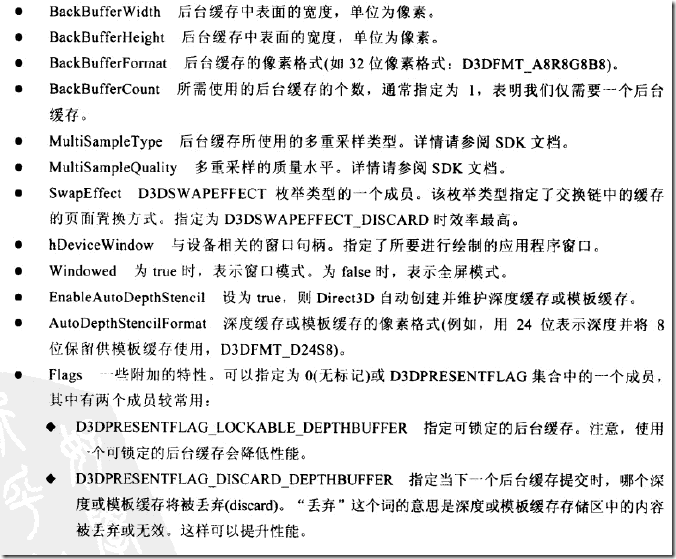Direct3D 9学习笔记(1)初始化
2012-07-27 13:35 Clingingboy 阅读(826) 评论(0) 编辑 收藏 举报
参考书籍:DIRECTX9.03D游戏开发编程基础
一.创建IDirect3D9接口
//-----------------------------------------------------------------------------
// Global variables
//-----------------------------------------------------------------------------
LPDIRECT3D9 g_pD3D = NULL; // Used to create the D3DDevice
LPDIRECT3DDEVICE9 g_pd3dDevice = NULL; // Our rendering device
//-----------------------------------------------------------------------------
// Name: InitD3D()
// Desc: Initializes Direct3D
//-----------------------------------------------------------------------------
HRESULT InitD3D( HWND hWnd )
{
// Create the D3D object, which is needed to create the D3DDevice.
if( NULL == ( g_pD3D = Direct3DCreate9( D3D_SDK_VERSION ) ) )
return E_FAIL;
// Set up the structure used to create the D3DDevice. Most parameters are
// zeroed out. We set Windowed to TRUE, since we want to do D3D in a
// window, and then set the SwapEffect to "discard", which is the most
// efficient method of presenting the back buffer to the display. And
// we request a back buffer format that matches the current desktop display
// format.
D3DPRESENT_PARAMETERS d3dpp;
ZeroMemory( &d3dpp, sizeof( d3dpp ) );
d3dpp.Windowed = TRUE;
d3dpp.SwapEffect = D3DSWAPEFFECT_DISCARD;
d3dpp.BackBufferFormat = D3DFMT_UNKNOWN;
// Create the Direct3D device. Here we are using the default adapter (most
// systems only have one, unless they have multiple graphics hardware cards
// installed) and requesting the HAL (which is saying we want the hardware
// device rather than a software one). Software vertex processing is
// specified since we know it will work on all cards. On cards that support
// hardware vertex processing, though, we would see a big performance gain
// by specifying hardware vertex processing.
if( FAILED( g_pD3D->CreateDevice( D3DADAPTER_DEFAULT, D3DDEVTYPE_HAL, hWnd,
D3DCREATE_SOFTWARE_VERTEXPROCESSING,
&d3dpp, &g_pd3dDevice ) ) )
{
return E_FAIL;
}
// Device state would normally be set here
return S_OK;
}
参考:http://msdn.microsoft.com/en-us/library/bb174300%28VS.85%29.aspx
二.创建IDirect3DDevice9
http://msdn.microsoft.com/en-us/library/bb174313(v=vs.85).aspx
HRESULT CreateDevice(
[in] UINT Adapter,
[in] D3DDEVTYPE DeviceType,
[in] HWND hFocusWindow,
[in] DWORD BehaviorFlags,
[in, out] D3DPRESENT_PARAMETERS *pPresentationParameters,
[out, retval] IDirect3DDevice9 **ppReturnedDeviceInterface
);
关于D3DPRESENT_PARAMETERS:Describes the presentation parameters.
http://msdn.microsoft.com/en-us/library/bb172588(v=vs.85).aspx
/* Resize Optional Parameters */
typedef struct _D3DPRESENT_PARAMETERS_
{
UINT BackBufferWidth;
UINT BackBufferHeight;
D3DFORMAT BackBufferFormat;
UINT BackBufferCount;
D3DMULTISAMPLE_TYPE MultiSampleType;
DWORD MultiSampleQuality;
D3DSWAPEFFECT SwapEffect;
HWND hDeviceWindow;
BOOL Windowed;
BOOL EnableAutoDepthStencil;
D3DFORMAT AutoDepthStencilFormat;
DWORD Flags;
/* FullScreen_RefreshRateInHz must be zero for Windowed mode */
UINT FullScreen_RefreshRateInHz;
UINT PresentationInterval;
} D3DPRESENT_PARAMETERS;
三.检测显卡功能
D3DCAPS9 caps={};
g_pD3D->GetDeviceCaps(D3DADAPTER_DEFAULT,D3DDEVTYPE_HAL,&caps);
if(caps.Caps & D3DDEVCAPS_HWTRANSFORMANDLIGHT)
{
}



